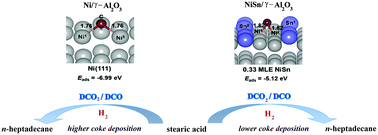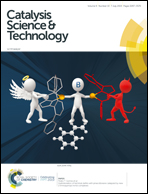Role of Sn promoter in Ni/Al2O3 catalyst for the deoxygenation of stearic acid and coke formation: experimental and theoretical studies†
Abstract
The effect of Sn promoter on a Ni/γ-Al2O3 catalyst towards the catalytic activity and catalyst stability via the deoxygenation of stearic acid for the production of diesel-range hydrocarbons has been investigated herein. The decarboxylation (DCO2) and decarbonylation (DCO) of stearic acid using NiSn catalysts are proposed as the main pathways to produce n-heptadecane (n-C17H36), whereas hydrodeoxygenation (HDO) is a minor pathway, as confirmed by the high ratio of C17 to C18 alkanes. Moreover, the Sn promoter in Ni/γ-Al2O3 significantly improves the catalyst reusability by enhancing the tolerance to the carbon-induced deactivation. This improvement was investigated by a density functional theory (DFT) calculation. The calculation results clearly explained that the Sn promoter can weaken the interaction between carbon and the catalyst surface, tending to prevent carbon segregation on the NiSn surface. This retardation of coke formation expands the life time of the catalyst, leading to a cost-effective approach for industrial processes.



 Please wait while we load your content...
Please wait while we load your content...